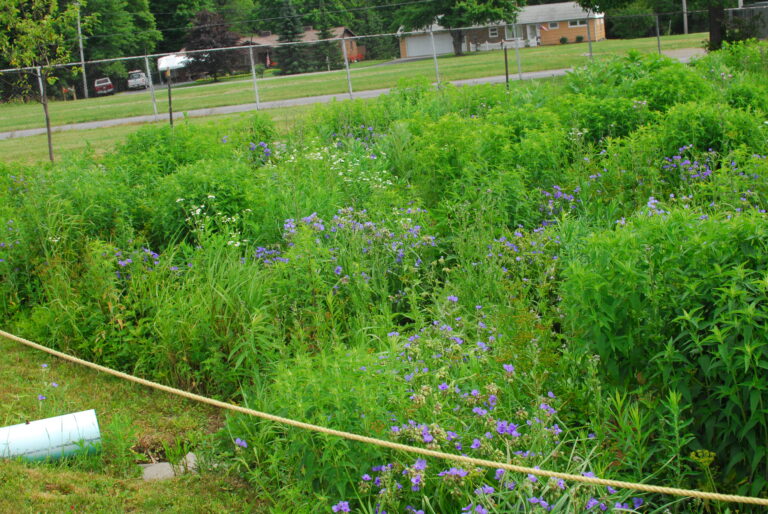Water is one of your land’s most powerful resources. Managed well, it nourishes soils, supports native plants, and sustains pollinators. Managed poorly, it strips away topsoil, floods low areas, and washes nutrients downstream where they damage waterways.
Understanding how water moves across your property, and how to guide that movement, is essential for healthier landscapes and ecosystems.
In this blog, we’ll cover:
- The consequences of poor water management and how to recognize them
- Practical strategies that use natural features to slow, spread, and soak in water
- Native plants that perform best in wet and dry zones of the Northeast
- The long-term ecological benefits of working with your land instead of against it
Let’s begin by looking at what poor water management actually looks like.
Recognizing the Signs of Poor Water Management
Poor water management accelerates erosion. The resulting loss of topsoil reduces fertility and makes it harder for native plants to establish. Nutrients and pesticides carried away in runoff can fuel algal blooms in streams and ponds, degrading fish and amphibian habitats. Areas that remain flooded too long often shift toward invasive species, while native wildflowers and grasses disappear.
But here’s the good news: many of these problems are easy to diagnose. By observing your land during and after rainfall, you can identify where water behaves in ways that harm your soil, and where small interventions can make the biggest difference.
How to Assess Your Land’s Natural Features
To start, walk your property during or shortly after a heavy rain. Pay attention to how the water moves, where it pools, and where it disappears. This will help you identify both risks and opportunities.
Some key things to look for include:
- Erosion gullies on slopes – Flowing water cuts channels that strip away fertile topsoil and create unstable ground.
- Sediment and muddy runoff – Water leaving your land carrying soil particles or nutrients with it, often visible as cloudy streams or puddles.
- Standing water – Depressions that hold water for days suffocate plant roots and encourage weeds or invasives.
- Sparse or patchy vegetation – Areas that fail to support healthy growth often signal compaction, drainage issues, or nutrient depletion.
- Collapsing banks or turbid water – Along streams or ditches, eroded edges, and cloudy runoff point to nutrient and soil loss.
Each of these conditions is evidence that water is not infiltrating the way it should. Instead of soaking into the soil to recharge groundwater and nourish deep-rooted natives, it is either escaping the site or pooling in ways that stress vegetation.
Make a Map
Mapping or sketching these problem areas can be helpful, especially on larger properties. By pairing visible signs of stress with the natural contours and soil types of your land, you’ll start to see how water is behaving across your site.
6 Practical Steps for Better Water Management
Once you’ve identified where water is moving too quickly, pooling, or escaping your site, the next steps are to find ways to work with the land instead of against it.
The goal is always the same: slow water down, spread it out, and allow it to soak in.
The six steps below combine physical land features with native plants, giving you practical tools that improve both ecological function and long-term resilience.
1. Use Land Contours to Your Advantage
Water always follows gravity, and slopes are where erosion begins. By planting along the contour of your land, you slow runoff and give water a chance to infiltrate the soil instead of carving channels.
How to do it:
- On gentle slopes, align plantings in curved rows that follow the natural contour.
- On steeper ground, consider small berms or terraces to intercept water.
- Stabilize these areas with deep-rooted native grasses that anchor the soil.
Recommended species: Switchgrass (Panicum virgatum), Virginia wildrye (Elymus virginicus), little bluestem (Schizachyrium scoparium). All three are available through Ernst’s conservation and erosion control mixes.
2. Plant Riparian Buffers and Wetlands
Streams, ponds, and drainage ditches are natural collection points, but without protection, they quickly become channels for nutrient and sediment loss. A vegetated buffer acts as a living filter, capturing runoff before it reaches open water.
How to do it:
- Maintain or plant strips of native trees, shrubs, and grasses along all waterways.
- Aim for at least 35 feet of continuous vegetation if possible.
- Mix deep-rooted grasses with moisture-tolerant shrubs and wildflowers for full coverage.
Recommended species: Gray dogwood (Cornus racemosa), buttonbush (Cephalanthus occidentalis), Virginia wildrye (Elymus virginicus), swamp milkweed (Asclepias incarnata). Ernst offers specialized Riparian Buffer Mixes tailored to these conditions.
3. Install Rain Gardens and Bioswales
Hard surfaces like rooftops and driveways concentrate runoff. Rain gardens and bioswales capture that water and let it infiltrate the ground.
How to do it:
- Create a shallow depression (6–12 inches deep) in a low point where water naturally flows.
- Fill with a soil mix that drains within 24 hours to avoid mosquito breeding.
- Plant with natives that tolerate both wet and dry conditions.
Recommended species: Blue flag iris (Iris versicolor), swamp milkweed (Asclepias incarnata), purple coneflower (Echinacea purpurea). Ernst’s Stormwater Management Mixes contain many of these species in ready-to-use blends.
4. Convert Lawns to Native Meadows
Turfgrass is shallow-rooted and sheds water. In contrast, native meadows absorb and store large amounts of rainfall, while requiring far less maintenance once established.
How to do it:
- Replace portions of lawn with a meadow mix suited to your site’s sun and soil.
- Expect a 2–3 year establishment period before meadows reach full maturity.
- Maintain with a single annual mowing in late fall or early spring.
Recommended species: Ernst offers multiple Northeastern Pollinator and Wet Meadow Mixes designed for this purpose.
5. Match Plants to Microzones
Every property has zones that differ in soil, slope, and moisture. Matching the right species to the right place ensures long-term success.
How to do it:
- In wet soils, plants must tolerate both saturated roots and occasional flooding. Species that evolved in marshes, streambanks, or wet meadows have adapted to low-oxygen soils and can survive standing water for days at a time. Their fibrous root systems also help stabilize wet ground and filter runoff.
Recommended species: blue vervain (Verbena hastata), boneset (Eupatorium perfoliatum), Blue flag iris (Iris versicolor), swamp milkweed (Asclepias incarnata).
- In dry or upland soils, plants need to handle fast-draining, sometimes drought-prone conditions. These species usually develop extensive taproots or dense, fibrous root networks that allow them to access deeper soil moisture. They are often found in prairies, glades, or sandy uplands and will outcompete species that require steady moisture.
Recommended species: little bluestem (Schizachyrium scoparium), purple coneflower (Echinacea purpurea), rough-stemmed goldenrod (Solidago rugosa), black-eyed Susan (Rudbeckia hirta).
Use Ernst’s Seed Finder Tool to select species or mixes adapted to your exact conditions.
6. Maintain and Monitor Plantings
Even the best-designed system needs care during establishment. Once rooted, natives largely take care of themselves.
How to do it:
- Water deeply during the first growing season; avoid frequent shallow watering.
- Control weeds in years 1–3 until natives dominate.
- Inspect after storms for erosion, standing water, or invasive species. Replant as needed.
Recommended approach: Rely on Ernst’s site-specific mixes for reinforcement plantings. They are designed to integrate with existing native stands.
Bringing It All Together
Each of these strategies works independently, but together they form a holistic approach to water management. Contour plantings slow runoff before it reaches low ground. Rain gardens and bioswales capture excess stormwater. Meadows and buffers filter and absorb what remains. The result is a property that retains more rainfall, loses less soil, and sustains a wider diversity of native plants and pollinators.
The Broader Benefits of Native Plant Water Management
The advantages of water management extend far beyond preventing erosion or flooding. When you slow water down and give it space to infiltrate, you strengthen every part of the ecosystem.
- Biodiversity gains – Native plantings support pollinators, birds, and amphibians, creating healthier food webs.
- Reduced inputs – Deep-rooted species minimize the need for fertilizer and irrigation once established.
- Climate resilience – Meadows, buffers, and rain gardens help land recover more quickly from both floods and droughts.
In the Northeast, where intense rainfall events are becoming more common, these strategies offer stability that conventional landscaping cannot. Good water management not only protects your soil and waterways but also ensures your property thrives as a functioning part of the larger environment.
How Ernst Can Help You Achieve Better Water Management
Effective water management is one of the many keys to building a resilient landscape that protects soil, supports pollinators, and improves water quality. By assessing your land’s natural features and using native plantings like meadows, buffers, and rain gardens, you create a system that is both functional and ecologically rich.
Through our decades of experience, Ernst Conservation Seeds has learned first-hand which plants work best for water management. We’ve created region-specific mixes for all types of land and offer expert guidance to help you achieve the best results.
If you have unanswered questions or would like tailored advice for your unique project, reach out to the team at Ernst. With the right strategy and the right seed, your land can work with water instead of fighting against it.

